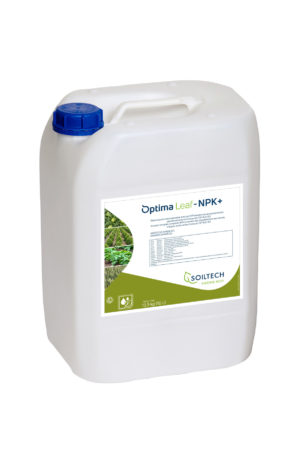If the nutrient uptake through the roots is inhibited (e.g. due to a low or too high soil pH, root damage, drought and/or heat), crop growth and development can stagnate. Foliar fertilisers can be applied as a preventive measure. We already informed you about this in our article: “The sense and nonsense of foliar fertilisers”. However, as with so many products, a foliar fertiliser's effectiveness is greatly dependent on using the correct application technology and getting the timing right. This article explains the best way to apply foliar fertilisers.
Nutrient uptake via the foliage
The main function of the foliage is gas exchange (CO 2 and O 2) and creating an efficient sap stream through transpiration, after which the plant can use sunlight for the process of photosynthesis. The roots in particular play a crucial role in the nutrient uptake, but numerous studies have demonstrated that the foliage is also capable of effectively absorbing nutrients and small organic molecules. This can take place in three different ways:
- Via the openings or pores in the leaves (stomata)
- Via the pores around the tiny hairs on the leaf surface (trichomes)
- Via diffusion through the waxy cuticles and the epidermal cells
It is generally assumed that nutrient uptake though diffusion and via the stomata are the main paths for the absorption of fertilisers.
Unlike nutrient uptake through the roots, nutrient uptake by the foliage is a passive process. If the external concentration of nutrients on the foliage is higher than internal concentration, the nutrients from the higher concentrated area will move - or diffuse - toward areas of lower concentration. This process involves a significant risk: if an excess of one or more nutrients is absorbed, this not only disturbs the metabolism of the foliage, but also causes nutrient burn. Therefore, the challenge in formulating foliar fertilisers is to offer the optimal amount of nutrients without the presence of ballast salts (see figure 1). This then supplies the plants with nutrients without damaging the crop.

Figure 1: Spray treatment of radish with left a Soiltech foliar fertiliser and right an alternative foliar fertiliser. The recommended dosage has been applied. The dosage of the fertiliser is the same in both spray treatments. The foliar fertiliser of Soiltech does not damage the crop, the alternative product does.
Effective application of foliar fertilisers
No two plants are the same. This implies that we have to deal with a wide diversity of types and composition of the leaf surface. Clear differences can be observed between different crops and even between different cultivars, while factors such as the age of the leaf and weather conditions also greatly determine the composition of the foliage and how efficiently it can uptake nutrients.
In regard to practical application, research reveals that, among other things, humidity (RH) and leaf wetness periods have a major impact on the efficient uptake of a foliar fertiliser. The nutrients in the fertiliser must be dissolved in water in order to be able to penetrate the plant. A high RH and longer leaf wetness periods therefore have a positive effect on nutrient uptake. For this reason, preferably apply a foliar fertiliser in the early morning or late afternoon/ early evening when there is a higher probability of a high RH and a long leaf wetness period. Also use sufficient volumes of water to ensure correct distribution of the spray liquid on the foliage. Adding a wetting agent also has positive effects.
Influence of the formulation of a leaf fertiliser
Finally, the formulation of the fertiliser is naturally vital for its efficiency. Salts in solution, such as manganese nitrate, potassium sulphate or zinc carbonate, may will be able to penetrate the crop, but in many cases uptake via the leaves is more difficult. In addition, they also input unnecessary ballast salts. As mentioned above and shown in figure 1, using salts as a foliar fertiliser can easily cause nutrient burn.
Soiltech's foliar fertilisers all contain organically complexed nutrients. This means that the relevant nutrient (e.g. Mg2+, Fe2+, Mn2+, K+ …) is bound by its positive electrical charge to a negatively charged organic molecule. This offers the benefit that, in addition to the absence of ballast salts, Soiltech's foliar fertilisers will not react with other products in the tank mix. The organically complexed foliar fertilisers from Soiltech also promote the uptake and (with mobile elements such as nitrogen and potassium) distribution in the crop, so that nutrients are supplied not just to the foliage, but also to the parts of the crop to be harvested (see figure 2).


Figure 2: Leaf and tuber weight of radish after a foliar application of Optima Leaf-NPK+ (2x 4 l/ha) and five alternative NPK foliar fertilisers (dosage according to label) compared with untreated crop (water control). Most foliar fertilisers do not result in any extra growth on parts of the crop above the soil. Optima Leaf-NPK+ is the only one of the trialled foliar fertilisers to produce more tuber growth. Contrary to the other products in the trial, Optima Leaf-NPK+ has demonstrated its high effectiveness. Application of Optima Leaf-NPK+ gives a more efficient crop with more tuber growth as a result.
